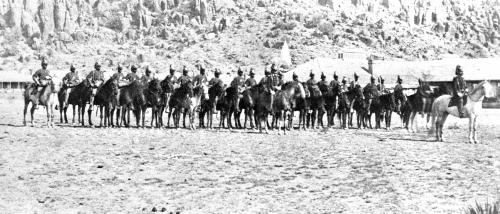Fort Davis stands unique among frontier forts in that it became the Regimental Headquarters for all four Buffalo Soldier regiments that served during the last decades of the 19th-century. Troopers of the Ninth Cavalry were the first Buffalo Soldiers to garrison Fort Davis. Arriving in the summer of 1867, they reoccupied the fort that had been abandoned by Union forces at the outbreak of the Civil War. In addition to helping construct a new post, they had the responsibility of protecting travelers on the San Antonio-El Paso Road, a segment of the southern Overland Route to California.
The Ninth was soon joined by companies of the Twenty-fourth Infantry. Performing the usual, tedious, everyday duties in garrison, they also provided an invaluable service scouting, guarding water holes, repairing telegraph lines, and escorting wagon trains, survey parties, and stage coaches.
With the arrival of two companies of the Twenty-fifth Infantry in July of 1870, Buffalo Soldiers from three regiments were now stationed at the post. The troops were involved in numerous expeditions against Apaches into the Guadalupe Mountains and the southern Staked Plains of western Texas. Although rarely encountering the elusive Apaches, these Buffalo Soldiers proved that troops could survive in rugged mountains areas and regions almost void of water.
Perhaps the most important field work for the men of the Twenty-fifth was constructing over 91 miles of telegraph line west from Fort Davis. The line became a vital communications link during operations against the aggressive and powerful Apache leader Victorio. The major campaign occurred in 1879-1880. Buffalo Soldiers of the Tenth Cavalry, who first arrived at the fort in 1875, and the Twenty-fourth Infantry, forced Victorio to retreat into Mexico where he was later killed by Mexican troops.
In 1881, the court-martial of the first African-American graduate of the U.S. Military Academy, Lt. Henry O. Flipper, played out at Fort Davis after he was accused of making false statements and embezzling funds. The appropriateness of his punishment is still debated.
In the history of Fort Davis, the Buffalo Soldiers amassed a notable record of accomplishments. They arrived at the post in 1867 when western Texas was still very open to attack by raiding Apaches and Comanches. When the Tenth Cavalry left in 1885, peace largely prevailed. The success of these soldiers, many being emancipated slaves, would have civil rights implications for many years to come.
For more information please visit the park’s website at http://www.nps.gov/foda .




















